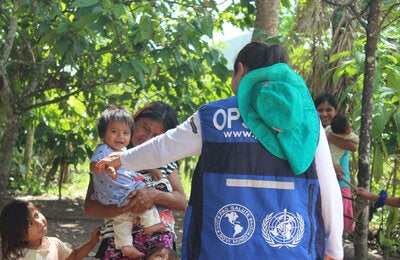Washington, D.C., August 10, 2010 (PAHO) — The World Health Organization (WHO) announced today that the 2009 H1N1 pandemic has effectively ended, and the world has moved into a "post-pandemic" phase characterized by traditional seasonal patterns of influenza.

"The new H1N1 virus has largely run its course," WHO Director-General Dr. Margaret Chan said in a telephone news conference. "During the pandemic, H1N1 crowded out other influenza viruses to become the dominant circulating virus. This is no longer the case."
The announcement came following a meeting earlier today of the Emergency Committee of the International Health Regulations (IHR), which consists of leading experts on influenza who provide advice to WHO based on the latest epidemiological and virological data.
Dr. Chan said the committee's advice to declare an end to the pandemic was based on the global situation but also took into account significant influenza activity in several countries. Among the key factors considered were:
- Influenza outbreaks worldwide have returned to levels of intensity that are characteristic of normal influenza seasons.
- H1N1 is no longer the dominant influenza virus but is part of a mix of circulating viruses.
- Large numbers of people now have some immunity to the H1N1 virus as a result of infection, exposure, or vaccination campaigns.
Dr. Chan cautioned, however, that ongoing vigilance is needed to ensure that the virus does not unexpectedly reemerge as a threat. "We expect the virus to continue to circulate for some years to come."
Dr. Mirta Roses, Director of the Pan American Health Organization (PAHO), joined Dr. Chan in emphasizing the need for continued vigilance, especially on the part of PAHO/WHO member countries in Latin America and the Caribbean.
"Influenza viruses are highly unpredictable. We need to keep up surveillance and reporting to ensure that we are not taken by surprise as a result of any such change," said Dr. Roses.
During the past 16 months, the 2009 H1N1 pandemic virus reached every WHO region and affected all but a handful of the world's countries. Officially, the virus has caused approximately 18,500 deaths. That figure, however, is based only on laboratory-confirmed cases. Dr. Keiji Fukuda, WHO's leading influenza expert, described the number as a "minimum" and said it may take several years to develop more accurate death toll numbers based on traditional methods of estimating influenza deaths.
In the Americas, more than 8,500 laboratory-confirmed deaths due to H1N1 have been reported (as of early August) to PAHO. Outbreaks in Latin America and the Caribbean peaked in April—August 2009 and, in a number of countries, stretched the capacity of national health systems to handle the large number of cases. Among the hardest hit countries were Mexico and the countries of the Southern Cone.
Dr. Roses noted that the H1N1 virus continues to circulate at low levels, along with other influenza viruses, in Latin America and the Caribbean and that it could still cause outbreaks that could have significant effects on local communities.
Moreover, the H1N1 virus could change—through antigenic drift—in ways that make people's current immunity less protective. In addition, countries that were less affected during the pandemic could see more severe disease from H1N1 in a future season.
For these reasons, PAHO is urging health authorities in its member countries in Latin America and the Caribbean to:
- Maintain surveillance of influenza virus, influenza-like illness and severe acute respiratory illness, and monitor and investigate unusual events, such as clusters of severe respiratory illness or death.
- Report to PAHO/WHO changes such as sustained transmission of antiviral-resistant H1N1 virus, human cases of infection with any influenza virus not known to be circulating in human populations, or significant changes in the epidemiological or genetic characteristics of H1N1 or other influenza viruses.
- Continue to vaccinate against the H1N1 virus, using monovalent (single virus) H1N1 vaccine or trivalent seasonal vaccine (which now contains H1N1), depending on availability. This is particularly important for high-risk groups, including pregnant women.
- Continue to provide appropriate care for people suspected of illness from influenza, including treatment with anti-viral medicines for groups at increased risk of severe illness.
Dr. Roses also said that PAHO member countries should review their national pandemic preparedness plans and make improvements to those plans based on experience gained during the 2009 H1N1 pandemic.
"We believe our work with member countries on preparing for a pandemic was a valuable investment in building capacity for surveillance and reporting and in strengthening health systems in general. But there is still much work to be done in both of these areas to ensure that our countries are better prepared for the next health emergency, whatever that might be."
PAHO was established in 1902 and is the world's oldest public health organization. It works with all the countries of the Americas to improve the health and quality of life of the people of the Americas and serves as the Regional Office for the Americas of the World Health Organization (WHO).



